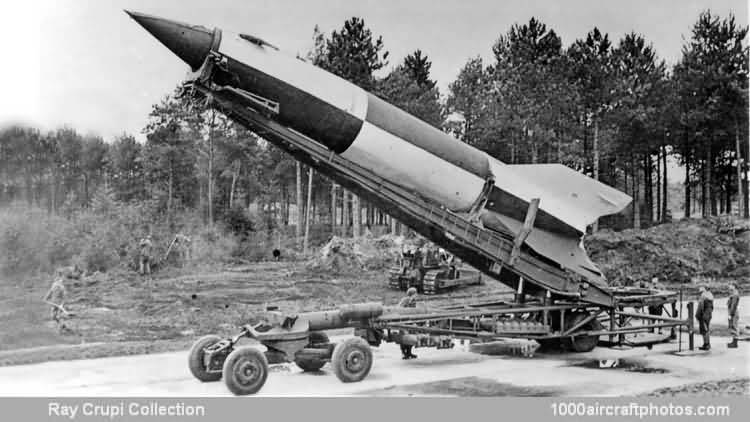Work on rockets and missiles was initially done at the Army's Kummersdorf-West proving ground, south of Berlin, later at the island of Borkum. As the scope of the work expanded, the Heereswaffenamt (Army Ordnance Board) and the RLM jointly purchased the northern peninsula of the Baltic island of Peenemünde in April in April 1936, providing some 290 mls (450 km) of launching range along the waters off the southern Baltic coast.
The Heeresversuchsanstalt (HV, Army Research Institute) at Peenemünde, eventually the largest of its kind in the world, was to become the clearing house for all German rocket work. It consisted of test beds and manufacturing facilities for the Army and was commanded by Colonel Leo Zanssen, Dornberger being the head of Weapon Test Section II and Wernher von Braun the technical director, while Dr Hermann headed the Forschungslabor (Research Laboratory), including a wind-tunnel.
The A4 rocket motor was fuelled with an alcohol (a mixture of 75% ethyl alcohol and 25% water), and liquid oxygen fuel. Static firing tests of the A4 engine began at Peenemünde on March 21, 1940, however, it was not until March 18, 1942, that the first complete A4 rocket was statically tested, only to result in an explosion. Subsequent tests and actual launchings also met with various failures, and only one really successful launching took place before the end of 1942. Nevertheless, there seemed little doubt that the rocket would eventually attain its planned range of 155 mls (250 km).
However, with the support of Armaments Minister Albert Speer, the plans for mass production were finally endorsed by Hitler on December 22, 1942. These plans were set back by shortages of men and materials (notably graphite for the gas rudders) and the RAF bombing attack on Peenemünde on August 17, 1943, in which many personnel were killed. Even so, a further step towards the operational use of the A4 was taken by setting up a training and production center at Peenemünde under the code name of "Heimat-Artilleriepark 11" ("Domestic Artillery Park 11") or "HAP 11".
Although an inclined launch would have been ideal, the size of the rocket, together with the need to minimize structural weight, made it necessary for a filled rocket to stand in the vertical position. Therefore the A4 was launched vertically,, staying vertical for 5 sec after liftoff, then completed a gradually tilt to 49 deg from the vertical in 50 sec (passing speed of sound 25 sec from liftoff), whereafter it attained that angle for 54 sec. At the calculated speed propellant was cut-off at an exact speed, depending on the requisite range, and coasting flight up and down a parabolic curve to the target, guided by gyro preset.
Despite unfavorable comparisons in official circles between the A4 rocket and the Fi 103 flying bomb, also being developed at Peenemünde, good performance by the A4 and poor performance by the then undeveloped Fi 103 in front of high officials during May 1943 kept the A4 program going. Furthermore, because of the deteriorating war situation, Hitler gave it the highest priority rating. From pilot production at Peenemünde, production was intended to reach up to 950 rockets a month at Henschel's Rax works and the Zeppelin works at Friedrichshafen.
However, these factories were bombed in the summer of 1943, and production lines were therefore set up underground in the Harz mountains near Nordhausen. From this vast manufacturing center, which was given the cover name of Mittelwerke GmbH, eighty-six A4s were delivered in July 1944, and from September a steady output of over six hundred A4s a month was achieved. Before this, in the summer of 1943, production of rocket components had begun at widely dispersed factories throughout occupied Europe.
With the final technical problems overcome, German rocket troops were deployed near Liege, Belgium and near the Hague, the Netherlands, in the summer of 1944. It was from Liege the first A4 offensive shot was made on September 5, 1944, aimed at Paris at a distance on 190 mls (305 km), four days later two were fired from the Hague, aimed at London at a distance of 195 mls (314 km). Although launchings were far below expectation, by the end of September the A4 was being heralded with great enthusiasm in official circles as Vergeltungswaffe 2 (V2, Retaliation Weapon 2).
About 6,000 A4s were constructed, however, only about half this number was launched by the Germans, 1,054 falling in Britain plus about 60 falling off the coast and 1,675 falling on the Continent. Although London had originally been the prime target, it was Antwerp which eventually received the hardest blow from the A4 since it received 1,265 hits compared with 517 hits on London."
Body diameter: 5 ft 5 in (1.651 m)
Diameter over fins: 11 ft 7.8 in (3.550 m)
Length: 46 ft 0.6 in (14.036 m)
Loaded weight: 28,440 lb (12,900 kg)
Warhead: 2,150 lb (975 kg)
Max velocity: 3,467 mph (5,580 kmh)
Impact velocity: 1,802 mph (2,900 kmh)
Trajectory height: 60 mls (97 km)
Range: 202 mls (325 km)
Flight time: over 189 mls (305 km) 3 min 40 sec
